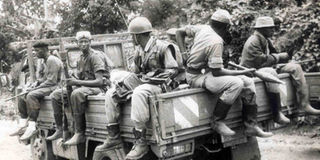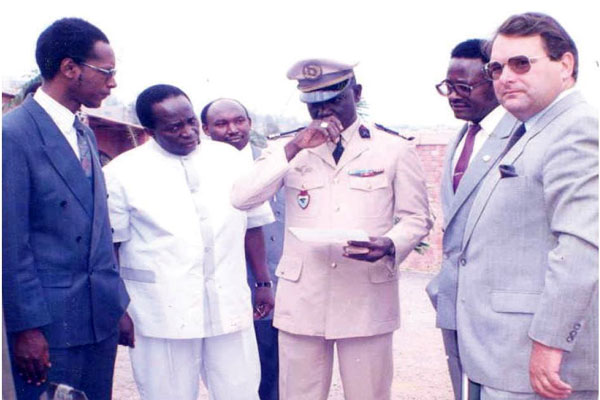Hearing about the genocide

Attack. Rwandan Patriotic Front fighters in February 1993 moved from their bases in northern Rwanda and had launched a devastating attack on the government troops, catching Habyarimana’s army totally unawares. FILE PHOTOS
What you need to know:
Part III: With their movements limited to Peter’s house, James Luyinda-Miti and his friends kept tabs on what was happening in the city through phone calls and radio announcements.
READ II:
Indeed, this young man never survived. He was among the very first people to be killed during the genocide. His death was confirmed to me by a little girl whom I met in Kigali in September, two months after the war.
She narrated to me that immediately the news of Habyarimana’s death was announced in their neighbourhood, the Interahamwe surrounded the homes of the so-called ibyitso and started killing them. One of the victims was Vedaste, who was dumped in a pit, alive, and buried together with some other young men.
Now back to the story inside Peter’s house. That night, we were so scared that we could not sleep. We kept vigil throughout the night, as we waited in vain for the official announcement promised by Radio Rwanda.
We started working out all possible solutions to our dilemma. We unanimously agreed that we had to leave Rwanda as immediately as it could be possible, whether what had happened had been a coup d’état, or an assassination by Habyarimana’s enemies, whoever they could have been.

RPF fighters at the base in northern Rwanda in 1994.
Massacres
At dawn, on Thursday, April 7, 1994, Radio Rwanda finally broke the silence. A military spokesman went on air and read out the long-awaited announcement.
We immediately noticed that something was amiss: in normal times, such statements would emanate from the Ministry of Information.
The minister of information was the government spokesman and he was the one who always issued communiqués on behalf of the government. Now, it was the army speaking! Our immediate conclusion was that the government had indeed been overthrown by some strongman in the army.
The general content of the announcement was as follows:
With deep sorrow, the Rwandan Armed Forces were informing the people of Rwanda that His Excellency Maj Gen Juvenal Habyarimana, the president of the republic, had passed away in a tragic air crash the previous night, as his plane was about to land at Kanombe Airport. The president was returning from Dar es Salaam, Tanzania, where he had spent the day in talks with his Tanzanian counterpart, president Ali Hassan Mwinyi. The president’s plane had been shot down by unknown people and the president, all his entourage, and the crew, had died instantly.
Furthermore, the president of Burundi, who had happened to be travelling on the same plane with president Habyarimana, was also among the dead, together with two of his ministers.
In a grim tone, the spokesman read out the names of the dead:
- His Excellency Maj Gen Juvénal Habyarimana, president of the Republic of Rwanda;
- His Excellency Cyprien Ntaryamira, president of the Republic of Burundi;
- Two ministers from Burundi, whose names we did not get;
- Maj Gen Deogratias Nsabimana, the army chief of staff;
- Ambassador Juvénal Renzaho, presidential advisor;
- Col Elie Sagatwa, presidential advisor;
- Maj Thaddée Bagaragaza, presidential advisor;
- Dr Akingeneye, the president’s personal physician;
- The three-man French crew of the presidential jet;

The gate to Peter’s house at Plot No 6, Rue de Masaka, the house in which the author and Fred Muwanga hid throughout the genocide.
The reader took a long pause. The silence was so intriguing that at first, we thought that the radio had gone off air! When he started speaking again, the officer read out a stern warning to the nation.
You could feel the anger in his voice.
The warning went out to everybody living on the territory of Rwanda. The following points were stressed:
1) Everybody was to remain indoors, to enable the armed forces find the inyangarwanda (enemies of Rwanda) that had killed the ‘Father of the Nation’.
2) Gatherings of more than two people were forbidden henceforth. That was to take immediate effect.
3) Only those employees on indispensable duties, such as hospital workers and newsmen, would be allowed to go to work and were to be picked from their respective homes by an official vehicle.
Another deep silence… This time, the communiqué had ended.
Momentarily, a frightening silence fell over Rwanda. Apart from the unconcerned birds that were chirping away their routine daybreak cacophony, it felt like the entire universe had suddenly gone to sleep….!
But, all of a sudden, the calm was broken by an incredible burst of shootings from all the corners of Kigali. Light weapons, automatic machine guns, grenade explosions, artillery fire and all sorts of arsenal seemed to be competing for space in the hitherto quiet and empty atmosphere. The three of us gazed at each other, as if each was asking the other which way to go.
The intensive shooting and explosions went on for about 10 minutes, and then abruptly died down, giving the impression that the shooters were following instructions from someone. We later learnt that the purpose of that show of firepower was to send shockwaves into the public and to subdue everyone into staying indoors, where the killers would easily find their potential victims.
We remained stuck in Peter’s sitting room, contemplating what to do next. From then on, we started hearing the vroom of vehicles as they passed by our house, crisscrossing the entire Kiyovu neighbourhood and beyond. Those were military vehicles. The massacre had begun.
The first round of killings targeted all those ‘big headed’ people who had given Habyarimana a hard time ever since the October 1990 attack by the RPF. As I mentioned earlier, lists of the ‘enemies’ of Rwanda had been drawn up and top security agents, as well as local leaders and the Interahamwe, knew exactly where to go once the whistle was blown. The whistle had just been blown!
The initial lists included prominent Tutsi politicians and businessmen, outstanding Hutu critics of the Habyarimana regime (mainly from the opposition PSD party), as well as all those prominent Hutu who had never openly come out to support the extremist policy of the MRND and its puppet CDR party.
All those individuals had been identified as having shown insubordination to Habyarimana in the past couple of months. Many had openly supported the Arusha Agreement, yet the extremist ideologues had vehemently opposed it and had, up to the time of the president’s death, managed to torpedo its implementation. Those people had to die!
The operation was to be carried out by soldiers from the feared special battalion known as the Presidential Guard, Habyarimana’s close protection unit, headquartered in Kimihurura. These fierce men, the only ones who wore black berets among all the Rwandan armed forces, were commonly known as ‘abajepe’, the Kinyarwanda version of the French acronym, GP (abbreviation for Garde Présidentille).
As a matter of fact, that particular battalion had already swung into action right from the previous evening, minutes after the presidential jet had crashed, erecting the first roadblock of the genocide at the Kimihurura roundabout (where the KBC business centre stands today). That was the very roadblock that Fred and I were about to land into, the previous night as we tried to leave Peter’s house, had it not been for that Mzungu (White) who had warned us not to proceed in that direction.
Thus, in Kigali, the killings of Tutsi and all those people associated with them, ‘officially’ started at dawn on Thursday, April 7, 1994.
Initially, though, it looked like a very well organised elimination of political opponents. By 10am, we had already received the first shocking stories by telephone: angry soldiers from the Presidential Guard had surrounded the ministers’ village in Kimihurura. Minister Lando was dead. He had been executed in his official residence, together with his Canadian wife and their two children aged about 15 and 13.
The minister of information, Faustin Rucogoza, was dead. So were PSD strongmen Ngango and Nzamurambaho, the men who had taken over the leadership of that party after Félicien Gatabazi had been assassinated in January.
The president of the constitutional court, Joseph Kavaruganda, had been killed. A prominent Tutsi businesswoman popularly known as Danie, along with her Mzungu husband, had also been murdered in their house in Kimihurura… That was from Kimihurura alone.

Author James Luyinda-Miti was working at the Kagera Basin Organisation in 1994 when the Rwanda Genocide broke out, claiming the lives of more than one million people. He survived the genocide and tells his story in this book.
Before we could digest all that shock, the most devastating news came in - government troops had stormed the official residence of prime minister Agathe Uwilingiyimana in Kiyovu (not far from where we were!), murdering her and her entire family. In addition, the soldiers had even killed the 10 Belgian bodyguards that been deployed at her residence by the UNAMIR!
We concluded that at this rate, this was going to be the bloodiest coup d’état Africa had ever known, much worse than what Samuel Doe had done in Liberia in 1980 …. We felt the danger getting very close to us.
Our families
The reader might be surprised that I am not mentioning anything about our families. As a matter of fact, none of us had his family in Kigali then. Over the past one or two years, political instability within Kigali had been dangerously on the rise.
As such, as tension mounted, especially between January and late March 1994, most foreign missions had advised their personnel to remain in a perpetual state of alert and had asked them to keep their families away from Kigali.
As for us, the Ugandans, the conditions were so bad that we had already taken that decision, at our own initiative, as early as 1993.
In actual fact, in a surprise move in February 1993, the RPF fighters had moved from their bases in northern Rwanda and had launched a devastating attack on the government troops, catching Habyarimana’s army totally unawares.
By the end of that attack, the retreating government soldiers were already within the outskirts of Kigali and the Inkotanyi were literally within shooting distance of the city.
There was a huge wave of panic among the diplomatic community; and immediately some semblance of normalcy was re-established, many of us decided to send our families back home. Thus, by April 6, 1994, almost all Ugandan personnel at the embassy or in the KBO were living without their families.
Furthermore, April 3rd 1994 had been Easter day. So, even those that had kept a few family members in Kigali had sent them home for the Easter vacation.
Tomorrow, read about how James Luyinda-Miti and his friends got more information about the fate of their other colleagues in the city and explore an escape route





